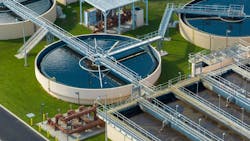A guide to food and beverage process water management
In many conversations with food and beverage processors, we realized one thing: process water management is not a priority until it is a problem.
But if saving money, ensuring compliance with municipal regulations, reducing water use ratios and minimizing greenhouse gases is important to your organization, managing process water in the right way is a must — and it can be a game-changer for the bottom line.
For food and beverage processors, process water can have a major impact on the bottom line — but process water is inherently challenging to manage. This guide is meant to shed light on the challenges faced in process water management and provide solutions, backed by case studies, that will help food and beverage processors make informed decisions on process water management at their facilities.
The essential role of process water management in the food and beverage industry
Process water is not just a byproduct of food and beverage processing; it is essential for sustainable business practices, production continuity and protecting a company's reputation. Due to its significance, effective process water management becomes not only a necessity but an imperative for long-term growth.
For food and beverage processorss, proper process water treatment is crucial due to the nature of production. As a water-intensive industry, food and beverage processing produces high volumes of process water. This process water contains high concentrations of organics (such as sugars and starches) which must be removed from the water to avoid fines, legal repercussions and reputational risks, and to meet regulatory compliance.
But when managed effectively, process water presents an opportunity to not only achieve sustainability goals but improve the bottom line. By enabling resource recovery and reuse, increasing operational efficiency and enhancing corporate image, a good process water treatment strategy can have positive financial ramifications.
Now let’s get into the challenges and considerations for specific process water types based on specific food and beverage processing verticals.
Bottling facility process water
For bottling facilities and beverage processs, the primary challenges with process water are high organic concentrations — reflected as biological oxygen demand (BOD) and chemical oxygen demand (COD) — variation in process water volume and composition, and managing water use. Managing expired or discarded products also becomes a challenge as discharging these returns may invoke high surcharges from utility unless a pretreatment step is in place prior to discharge.
These challenges occur at different parts of production processes and must be managed to avoid production disruptions, fines and even shutdowns. When planning for growth and expanding product lines, be sure to take process water into consideration.
Case study: Exceeding process water KPIs for PepsiCo
PepsiCo came to Aquacycl looking to solve their high BOD challenge associated with their returns while meeting their climate and water goals. After an audit of their process streams, we found that 60% of their process water’s organic concentration came from 3% of their total discharge volume, which was more than doubling their sewer surcharges in certain months.
By optimizing a stream separation approach and treating that small volume of high-concentration process water and returns with an onsite pre-treatment system, we were able to significantly reduce historic surcharge variations. The plant experiences up to a 30% monthly savings on their process water discharge costs, and now mitigates over 1,000 tons of CO2e and 400,000 kWh of energy for the city on an annual basis using this process water treatment.
Distillery process water
Distillery process water is especially unique because different types of spirits produce different effluents and byproducts that each come with their own challenges.
Tequila distillers primarily face challenges with the agave byproducts, like agave bagasse and vinasse. Whiskey distillers face challenges with the byproducts produced from different steps of the distillation process, primarily the pot ale, draff and spent lees. Rum distillers need to handle the sugarcane bagasse produced from sugarcane processing while vodka and gin distillers must handle starchy process water from fermenting potatoes and grains.
But despite the type of spirit you produce, water use management will always be a primary concern for distillers.
Case study: Enabling water reuse for Aspen Distillers
Aspen Distillers has a goal of becoming the nation’s most sustainable distillery. To fulfill this, they asked Aquacycl to design a process water treatment system that effectively treated their distilling process water and enable reuse of the treated process water for their adjacent farm.
To accomplish this, we installed our BioElectrochemical Treatment Technology (BETT) system that removes the bulk organics from the distillery process water, providing the availability of nutrient-rich water that will be used to irrigate adjacent agriculture. This system generates 90% less greenhouse gas emissions than any conventional treatment system, further supporting the distillery’s sustainability mission.
Brewery process water
Brewery process water is typically high in unfermented sugars, grain, hops and yeast solids, with trace amounts of alcohol, and variable pH and volume. These changing parameters all pose concerns to a utility as these characteristics can put strain on conventional treatment systems which could lead to a requirement for alternative discharge or onsite treatment at the brewery.
Most challenges to brewery process water come from the byproducts produced during the brewing process, primarily the spent grains, wort, spent yeast, and trub. You can handle these most effectively by employing a side streaming approach, treating streams generated from different parts of production separately, which will help save costs, reduce hauling, and maintain compliance.
Confectionery process water
The sugary, buttery and chocolatey streams that flow from confectionery production will give confectioners challenges with their process water treatment. Though the general challenges are shared — high organic load, variability and food coloring — each type of confectioner faces unique challenges with their process water.
Chocolate confectioners need to handle the fats, oils and grease (FOG) released in their process water from the processing of cocoa beans, caramel, cookies, etc. Sugar confectioners face elevated levels of COD which require pretreatment prior to discharge to avoid unnecessary fines. Finally, bakers encounter increased levels of total suspended solids (TSS) from flour residue and may require the implementation of settling steps to their production line to catch TSS before discharge.
Case study: Treating “sugarwater” for a confectionery producer
A confectionery company faced the challenge of treating their high sugar content streams (“sugarwater”) with their existing onsite aerobic treatment facility. Due to the high organic content and color of this stream, they would require dilution of their process water prior to hauling and land application, or pretreatment prior to entering their existing system.
Aquacycl utilized a BETT Demo Unit to treat this sugar water and reduce the organic load and color to levels that could be treated in the aerobic system. This unit resulted in significantly lower sludge production and a Net Energy Recovery (NER) of 1.6 kWh/ kg-COD removed. It produces the electricity as direct DC power with no methane.
Snack food manufacturing process water
Snack food manufacturers, particularly those handling starchy products, will typically have process water that contains elevated levels TSS, high organic concentrations (BOD/COD) and FOG. Without proper management, the process water stream poses concern to the utility and may result in hefty surcharges.
Starch overload, suspended solids, additives, food coloring and production variability all lend themselves to unique challenges with snack food manufacturing process water. The key to addressing these challenges lies in understanding the specific issues associated with a manufacturer's unique processes, identifying the origins of challenging process water characteristics throughout manufacturing and isolating when possible to address independently.
Getting started
Here are some key first steps to start optimizing process water management for all food and beverage processors:
- Map out your goals: What are your sustainability and business goals, and how does water factor in?
- Understand your process water: Employ regular testing and monitoring through the different areas of production to help you understand your process water composition and volume and determine the best treatment options.
- Explore treatment options: Whether it is offsite, onsite or through a utility, there are many treatment options out there to consider for your waste streams. The best choice to align with your business and sustainability goals will arise from your understanding of process water challenges.
- Formulate a plan: Assessing your costs, permits, goals and treatment options to achieve the best return on investment.
Feeling overwhelmed? Here is a handy process water management framework that will take you through an exercise to get you thinking about all aspects of process water management.
Luiza Moreno is a marketing specialist at Aquacycl.


